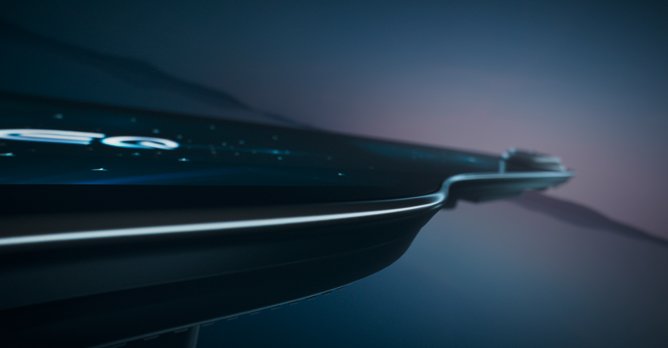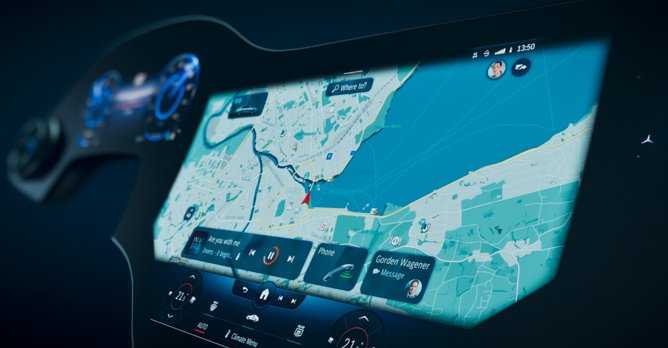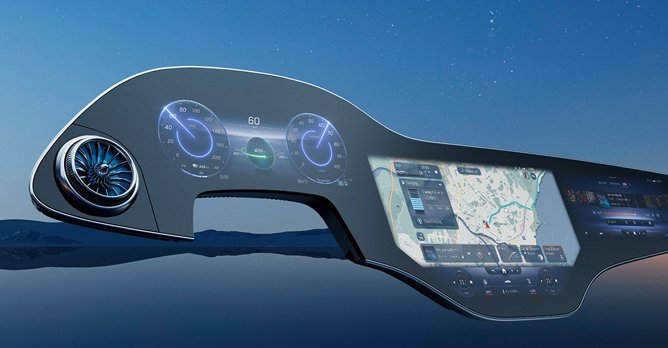The new Mercedes-Benz MBUX Hyperscreen
11 Jan 2021|1,630 views
Visually impressive, radically easy to operate and extremely eager to learn, the Mercedes-Benz User Experience (MBUX) Hyperscreen is one of the highlights in the EQS. It represents the emotional intelligence of the all-electric upper-class model.
The large, curved screen unit stretches almost the entire width from the left to the right A-pillar. In addition to its sheer size, the high-quality, detail-loving design also provides a 'wow' effect. This aesthetic high-tech look is the emotional dimension of the MBUX hyperscreen. Added to this is artificial intelligence (AI), with software capable of learning, the display and operating concept adapts completely to its user and makes personalised suggestions for numerous infotainment, comfort and vehicle functions.

MBUX has radically simplified the operation of a Mercedes-Benz. Unveiled in 2018 in the current A-Class, there are now more than 1.8 million Mercedes-Benz passenger cars equipped with it on the roads worldwide. A few months ago, the second generation of the MBUX debuted in the new S-Class. The next big step now follows in the form of the new EQS and the optionally available MBUX Hyperscreen.
The MBUX Hyperscreen is an example of digital/analogue design fusion - several displays appear to blend seamlessly, resulting in an impressive, curved screen band. Analogue air vents are integrated into this large digital surface to connect the digital and physical world.
The MBUX Hyperscreen is surrounded by a continuous plastic front frame. Its visible part is painted in an elaborate three-layer process in 'Silver Shadow'. This coating system achieves a particularly high-quality surface impression due to extremely thin intermediate layers. The integrated ambient lighting installed in the lower part of the MBUX Hyperscreen makes the display unit appear to float on the instrument panel.

However, the entertainment functions of the passenger display are only available during the journey within the framework of the country-specific legal regulations. If the passenger seat is not occupied, the screen becomes a digital decorative part. In this case, animated stars, like the Mercedes-Benz Pattern, are displayed.
For a particularly brilliant image, OLED technology is used in central and passenger displays. This is where the individual image points are self-luminous, non-controlled image pixels remain switched off, which means that they appear deep black. The active OLED pixels, on the other hand, radiate with high colour brilliance, resulting in high contrast values, regardless of the angle of view and the lighting conditions.
This electrifying display appearance goes hand in hand with emotionally appealing visualisation. All the graphics are styled in a new blue/orange colour scheme throughout. The classic cockpit display with two circular instruments has been reinterpreted with a digital laser sword in a glass lens.

Infotainment systems offer numerous and comprehensive functions. Several operating steps are often required to control them. In order to further reduce these interaction steps, Mercedes-Benz has developed a user interface with context-sensitive awareness with the help of artificial intelligence.
The MBUX system proactively displays the right functions at the right time for the user, supported by artificial intelligence. The context-sensitive awareness is constantly optimised by changes in the surroundings and user behaviour. Mercedes-Benz has investigated the usage behaviour of the first MBUX generation. Most of the use cases fall in the Navigation, Radio/Media and Telephony categories, thus the navigation application is therefore always at the center of the screen unit with full functionality.
Over 20 further functions - from the active massage programme through the birthday reminder, to the suggestion for the to-do list - are automatically offered with the aid of artificial intelligence when they are relevant to the customer.
Visually impressive, radically easy to operate and extremely eager to learn, the Mercedes-Benz User Experience (MBUX) Hyperscreen is one of the highlights in the EQS. It represents the emotional intelligence of the all-electric upper-class model.
The large, curved screen unit stretches almost the entire width from the left to the right A-pillar. In addition to its sheer size, the high-quality, detail-loving design also provides a 'wow' effect. This aesthetic high-tech look is the emotional dimension of the MBUX hyperscreen. Added to this is artificial intelligence (AI), with software capable of learning, the display and operating concept adapts completely to its user and makes personalised suggestions for numerous infotainment, comfort and vehicle functions.

MBUX has radically simplified the operation of a Mercedes-Benz. Unveiled in 2018 in the current A-Class, there are now more than 1.8 million Mercedes-Benz passenger cars equipped with it on the roads worldwide. A few months ago, the second generation of the MBUX debuted in the new S-Class. The next big step now follows in the form of the new EQS and the optionally available MBUX Hyperscreen.
The MBUX Hyperscreen is an example of digital/analogue design fusion - several displays appear to blend seamlessly, resulting in an impressive, curved screen band. Analogue air vents are integrated into this large digital surface to connect the digital and physical world.
The MBUX Hyperscreen is surrounded by a continuous plastic front frame. Its visible part is painted in an elaborate three-layer process in 'Silver Shadow'. This coating system achieves a particularly high-quality surface impression due to extremely thin intermediate layers. The integrated ambient lighting installed in the lower part of the MBUX Hyperscreen makes the display unit appear to float on the instrument panel.

However, the entertainment functions of the passenger display are only available during the journey within the framework of the country-specific legal regulations. If the passenger seat is not occupied, the screen becomes a digital decorative part. In this case, animated stars, like the Mercedes-Benz Pattern, are displayed.
For a particularly brilliant image, OLED technology is used in central and passenger displays. This is where the individual image points are self-luminous, non-controlled image pixels remain switched off, which means that they appear deep black. The active OLED pixels, on the other hand, radiate with high colour brilliance, resulting in high contrast values, regardless of the angle of view and the lighting conditions.
This electrifying display appearance goes hand in hand with emotionally appealing visualisation. All the graphics are styled in a new blue/orange colour scheme throughout. The classic cockpit display with two circular instruments has been reinterpreted with a digital laser sword in a glass lens.

Infotainment systems offer numerous and comprehensive functions. Several operating steps are often required to control them. In order to further reduce these interaction steps, Mercedes-Benz has developed a user interface with context-sensitive awareness with the help of artificial intelligence.
The MBUX system proactively displays the right functions at the right time for the user, supported by artificial intelligence. The context-sensitive awareness is constantly optimised by changes in the surroundings and user behaviour. Mercedes-Benz has investigated the usage behaviour of the first MBUX generation. Most of the use cases fall in the Navigation, Radio/Media and Telephony categories, thus the navigation application is therefore always at the center of the screen unit with full functionality.
Over 20 further functions - from the active massage programme through the birthday reminder, to the suggestion for the to-do list - are automatically offered with the aid of artificial intelligence when they are relevant to the customer.
Latest COE Prices
October 2025 | 1st BIDDING
NEXT TENDER: 23 Oct 2025
CAT A$128,105
CAT B$141,000
CAT C$74,301
CAT E$140,009
View Full Results Thank You For Your Subscription.
























